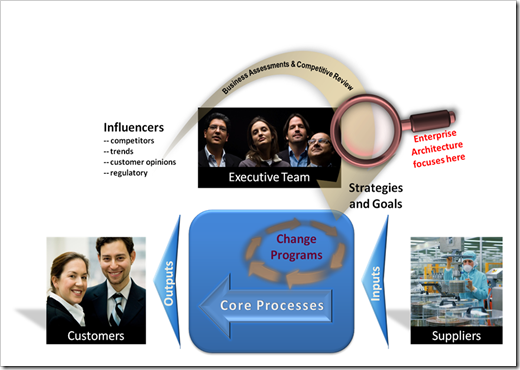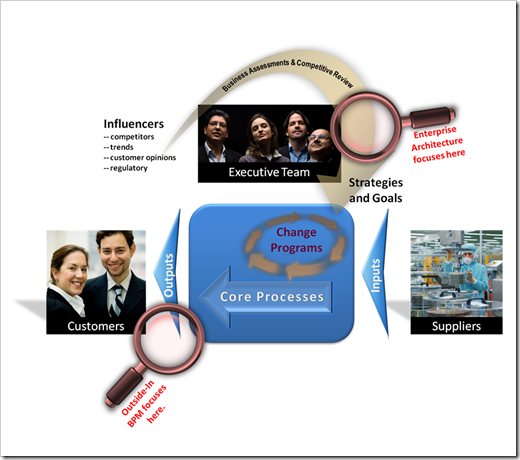Creating context between BPM and EA
I’ve spent some time in recent weeks focusing on the touchpoints between practitioners of BPM and the core processes of Enterprise Architecture. I’m looking for ways to improve common understanding, re-align processes, and reduce the friction that sometimes shows up when practitioners of these two different arts don’t understand one another’s goals and methods.
For the sake of this post, I will focus on customer centric aspects of BPM (also known as “Outside In” BPM). While this is not the only way that BPM adds value, and is perhaps not even the most common way, it is a common meme in articles and blogs. Proponents of this method can tell a strong story of value by focusing on improving customer experience.
Enterprise Architecture, as I’ve pointed out in prior posts, is focused on connecting business strategy to execution… but where do the strategies originate from? From thin air? Perhaps, from the latest issue of Business Week? (If so, find another job ;-). Strategies originate from business leaders (and their trusted advisors) reviewing and analyzing the influencers on the business, including customer opinions, to create a list of specific changes and goals that they would like to see. More importantly, strategies reflect an implicit prioritization: of all the things that the business could focus on, the strategy represents the specific goals that executives want the business to focus on.
Strategies are the output of a process of business assessment and competitive review, performed by the executive team. Once the executives have considered the various influencers, and performed a review of the business model and business performance, they make key decisions that result in business strategy. Among those list of business influencers is “customer opinion,” and they are taken into account in formulating strategy, especially where those opinions have an influence on business performance (loyalty, purchase behavior, brand value, etc).
The key observation from this combination is that “Outside-In” BPM is really all about providing ideas for improvement, but if those ideas are not fed in to the executive pipeline, and don’t result in a formal strategy from the business, then they are not part of the focus that the business is asking for. In other words, if an executive says “we should focus resources on creating new products,” she is not going to be happy to hear someone say “but we should focus on improving customer experience instead!” The result of that conversation is obvious: “I’ll back that, if you don’t spend any money on it.”
The combination of the two images above helps to illustrate how these two focus areas compare:
One conclusion that is fairly easy to draw: in order to maximize the impact of Outside-In BPM, make sure to break the effort into three parts.
- Step one is the analysis that determines that there exists an opportunity to impact the business by focusing on customer experience. No improvement yet… just an estimate of costs and benefits to influence the formation of business strategy.
- Step two is to work with executives to insure that they take that potential impact into consideration in the formulation of strategy.
- If a strategy emerges that indicates that they agree, then proceed to step three and begin a formal BPM process. Otherwise, your impact will be limited to performing BPM projects on a shoestring.
This is one place where Enterprise Architecture can help. By working with EA, the BPM professional can get the input they need to “position” the benefits of the customer-focused proposal to the business leader who has to balance the resources and benefits to serve the needs of the shareholders.


